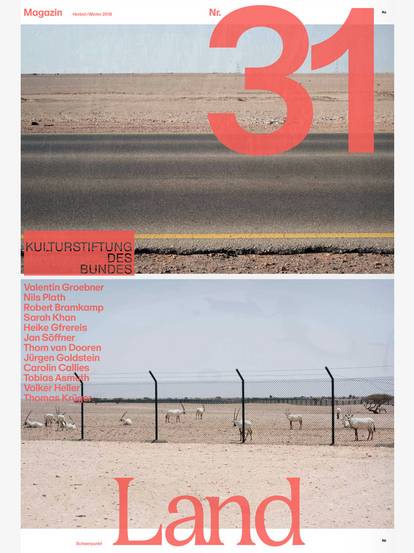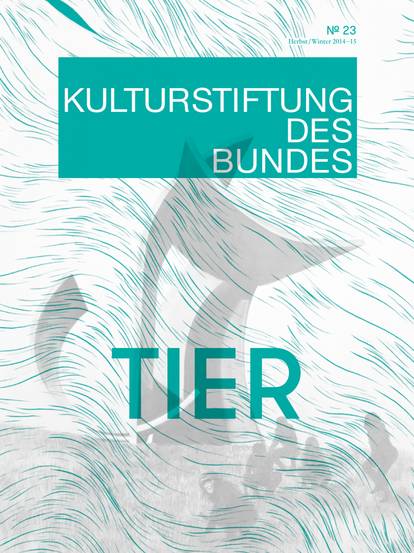An appeal to end the slaughter by Anne Peters
Our legal system currently permits widespread violence against animals, but it also has the potential to combat the exploitation and destruction of animals – and not just here, but worldwide. If we ever desire to draft an “animal bill of rights”, we need only to follow the course of human rights.
Gawking at people in the zoo
Between 1879 and 1935, residents of Basel found entertainment at so-called “People Shows” at the Basel Zoo. At these events, non-Europeans were put on display in traditional garb. The shows attracted even larger crowds than the zoo animals. The organisers of the “People Shows” were usually animal merchants and zoo directors. Those on display were often recruited from Sudan, a region in which most of the African zoo and circus animals were also captured. The organisers made sure that the people on display could not speak any European languages, which made verbal communication impossible between the zoo visitors and the displayed individuals. Births and babies were crowd-pleasers and especially welcome. The business correspondence referred to the exhibition of these human displays (in particular, their transportation by ship) in the same terms they used for animals. A zoo poster advertised the “endangered Female Lip Negros”. On 18 June 1887, the daily paper Basler Nachrichten wrote: “Huddled half-naked in front of their huts are several brown creatures whose physical development, surroundings and drapery are strongly reminiscent of the apes.”
Most of us today are shocked to learn of this recreational activity of the not-so-distant past. But why weren’t people shocked to see other human beings put on display in zoos 75 years ago? And why do we hardly question the practice of putting animals on display in zoos? Our views regarding human dignity have apparently undergone dynamic development in recent decades. A “People Show”, as described above, would be unimaginable in Europe today; it would be forbidden by law and declared a human-rights violation by the courts. Would it be desirable, could we imagine that in another 75 years we might shudder to think that we had once imprisoned animals in zoos and circuses – a practice, which by then would be forbidden as violating animals’ rights to freedom and dignity?
The human-animal continuum and the legal divide
“Animalité”? If we look back at the relevant discourse in philosophy, anthropology and zoology in the history of ideas, we notice that countless criteria have been used to demarcate the division between homo and animale, as the differentia specifica, the distinguishing characteristics of human beings, so as to justify their exceptional, superior position in the realm of living creatures. These made reference to cognition and self-awareness (reason, ability to speak, utilisation of tools, production of tools, etc.), as well as social and moral abilities (feeling sympathy for other species, passing down acquired techniques, i.e. culture). Naturally, the trait of possessing an immortal soul does not lend itself to an intersubjective plausibility analysis. All of the other allegedly distinctive characteristics of human beings have since been discredited by recent scientific findings.
Has the moment arrived when we must admit that there is no divide between man and beast, but rather a smooth transition, a new form of solidarity (“fraternité”)? Solidarity which over the years has extended to the entire legal community, to the dispossessed, women, children, foreigners, etc., in other words, groups which did not immediately share in the pleasure of liberty, equality and brotherhood following the French Revolution. Should such solidarity now extend further to include animals capable of feeling emotions and experiencing the world?
It is impossible to “derive” any ethical laws on human interaction with animals from the mere fact that there is a biological (and cultural) continuum (common ancestors, common genome, common traits and behaviours) between non-human and human animals. But our moral system is shaped to some degree by our reflection on scientific data. We can justifiably demand that this continuum is reflected in our legal system.
In contrast, our current laws are characterised by sharp discontinuity. A highly diversified body of national and international human rights stands in stark contrast to the almost non-existent rules regarding animal welfare. Granted, European nations in particular, the EU and the European parliament have passed a number of laws, regulating the treatment of animals since the 1980s (e.g. species protection, transportation, slaughter, animal husbandry, house pets). However, animals in Europe are only regarded as objects deserving protection, but not as legal entities. Furthermore, current animal protection laws still permit everyday mass violence against animals.
The legalisation of violence against animals
This violence is constituent of the two most important uses of animals in modern-day society, namely for food production and medical/pharmaceutical/chemical testing. The latter generates far more criticism, although it entails a quantitatively small amount of violence compared with that of food production. “Only” twelve million animals (70 percent of which are mice) are used for research purposes in the EU each year. In contrast, 450 billion animals are kept in captivity in industrial, large-scale facilities worldwide, and according to the data provided by the Food and Agricultural Organisation (FAO), 58 billion land animals are slaughtered each year. An approximately equal number of marine animals are killed each year, whereby 80 to 90 percent of the by-catch (dead or dying creatures) is tossed back into the ocean.
In Western industrialised societies, the animal-based foods are ridiculously inexpensive because of their industrialised production methods. A European household today spends an average of ten percent of its entire income on food, while back in the 1950s, one-third to one half of a family’s income was used for buying food. The average European consumer demands cheap products with certain characteristics. For example, in Switzerland (like in other European countries), the male offspring of laying hens are immediately killed after birth because they cannot be sold for their meat. According to Ruedi Zweifel, director of the Aviforum, the competence centre of the Swiss chicken poultry industry: “The optical aspect plays a decisive role (…). The carcasses of male chickens nowadays do not correspond with consumer expectations. They are not heart-shaped, but rather pointed.” (Neue Zürcher Zeitung, 23 March 2013). The newly hatched male chickens in Switzerland – quite a large number at 2.5 million a year – are usually “homogenated”, in other words, they are shredded which is explicitly permitted by the Swiss animal protection ordinance – one of the most stringent in the world.
The ordinance on “chick homogenisation” is just one of many examples of how our legal system facilitates and institutionalises the exploitation, discrimination and extermination of animals. There is a long tradition of employing laws against animals, as well as against human beings. The systematic exclusion of those who are different (often referred to as “othering”), e.g. Africans, Jews and aboriginal peoples, is often carried out by verbally, then legally, and finally physically excluding them from society, and their designation as animals is typical component of these strategies. Nazis called the Jews rats, while Europeans and US Americans defamed blacks and the Japanese as apes. The Hutu called the Tutsi cockroaches. Another “animalised” group were homosexuals. Until recently, several US states had laws on the books which forbid sodomy, i.e. sexual relations between people of the same sex or with animals, describing them as “crimes against nature” or “unnatural intercourse”. These and similar injuries cause divisions between superior groups of people and a different, “animal-like” group to rupture and, in the worst case, ultimately result in the physical destruction of the animal-like.
Liberation of animals through the legal process
On the other hand, our legal system has the potential to combat the exploitation, discrimination and extermination of animals. The welfare of animals, their needs and possibly their rights, are not only a matter of social justice, but of global justice. All of the central challenges, which we must address in our dealings with animals, are of a global nature. It’s about sustainability, climate, extinction, poverty and poor nutrition – all global problems. The animal-processing industry (food and pharmaceuticals) is a global industry. Commercial trade with animals and animal products is global, as well. A single country can do very little to improve cage conditions or animal testing on its own, because the respective branch can simply relocate to another country where standards are less stringent. And when individual nations attempt to keep these economically relevant branches in their country by providing them “attractive” (i.e. lax) legal regulations, the standards can start spiralling downwards at the expense of animal welfare. International laws also influence the options of individual states with regard to animal-related measures. Various free-trade agreements enforced by the World Trade Organisation (WTO) restrict the possibility of levying import bans on goods produced in a manner cruel to animals. For instance, the WTO Arbitration Board recently declared specific aspects of the EU import ban on sealskin products to be unlawful, which forced the EU to amend its regulations accordingly. This demonstrates that legal regulations aimed at improving animal welfare can only be effective if they can be enforced at a global level.
From human rights to animal rights
The question whether the distinctive traits of human beings mentioned above are in keeping with biological research is an empirical one. But it’s an ethical and legal question when we ask whether the distinctive criteria separating us from animals should be morally and legally relevant. Jeremy Bentham argued that animals’ sensibility to pain (in more modern terms, their capacity of perception and awareness) played an ethically critical role in their treatment. The famous “footnote 1” in the “Introduction to the Principle of Morals and Legislation” of 1781 concludes with the appeal: “The question is not, Can they reason? nor, can they talk? but, Can they suffer?” However, only few are aware that the footnote draws an explicit comparison to slaves: “Slaves (…) have been treated by the law upon the same footing as in England, for example, the (… ) animals are still.” Bentham’s argument, which remains valid today and forms the foundation of utilitarian ethical standards developed further by Peter Singer in Animal Liberation (1975), is based on parallels between slaves and animals.
With regard to animal protection laws currently in place, we also encounter numerous analogies to respected legal institutions established for human benefit. For example, there are the so-called “five freedoms” of animal husbandry, which date back to a report by an English animal welfare committee chaired by Roger Brambell in the 1960s, and have meanwhile become standard worldwide. These five freedoms are the freedom from hunger and thirst, from discomfort, from injury, pain and disease, the freedom to express their normal behavioural characteristics, and the freedom from fear and distress. Their structure and terminology strongly echo those of the (human-related) “four freedoms”, which US President Franklin D. Roosevelt articulated in 1941 before entering World War II (freedom of speech, freedom of worship, freedom from want, and freedom from fear).
A series of other legal concepts, which have thus far applied exclusively to humans, could also serve the benefit of animals. These include the institution of stewardship, decolonisation (i.e. setting them free) and the responsibility to protect. A current example is the Anglo-Saxon writ of habeas corpus. This guarantees protection from arrest and imprisonment without just cause; in the United States it was used in the legal battle against slavery. American animal rights activists in the state of New York are now using this writ in court to substantiate their argument for releasing chimpanzees from their pens.
The most controversial, but potentially most effective institution is that of law. For some time, animal ethicists have been claiming, as, for example, Paola Cavalieri has: “It is time to take the “human” out of human rights.” The question whether animals can and should have rights is of crucial importance, because its affirmation would overturn the prevailing anthropocentric justification of animal protection. Laws forbidding the abuse of animals (starting with English laws dating back to the 18th century) were primarily intended to protect public moral standards, avert social brutalisation and thereby prevent violence against humans. This line of thought was classically expressed by Kant in his “Metaphysics of Morals”. The “blunting of sympathy“, as Kant calls it, is indeed confirmed by more recent criminological research. In a Swiss study from 2011, self-assessment reports by young people showed that cruelty to animals correlated with a higher risk of committing criminal acts (though this does not prove a causal relationship).
An overview of the existing animal protection laws since the 1860s reveals that legislators have hardly shifted away from their anthropocentric reasoning. It is quite a different case when it comes to the evolution of laws protecting women and children. Originally, by which I mean until the start of the 20th century, all groups of norms served to protect public moral standards. Accordingly, animal cruelty was only forbidden if it took place in public. The early bilateral agreements outlawing trafficking of women and girls (i.e. “white” women and girls) were also implemented to protect morality, though women’s and children’s rights were yet unheard of. Meanwhile, a paradigm shift has taken place, in that these laws no longer serve to protect public moral standards, but rather the victims for their own sake.
Forces driving legal development
The slaughterhouses of 19th-century Chicago provide an historic example of the combination of discourse on human rights and animal welfare and the role of the public and economic sectors. Henry Ford adapted the innovative assembly-line technology used in the slaughterhouses for his automobile factories, and the Nazis drew inspiration from both to carry out industrialised mass murder. In 1905, the novelist Upton Sinclair wrote “The Jungle” – a belletristically wrapped condemnation of the cruelty to animals and the dangerous and exploitative working conditions at the slaughterhouses. The sickening, rotting meat served as a metaphor for capitalism. The public outcry was so resounding that the US Congress passed two hygiene laws within six months after the novel went to print. This case demonstrates how legal progress in a democratic system can be achieved. Potential voters were roused to action through artistic means, and the slaughterhouse lobby itself demanded stricter regulation in order to save face and improve business. To Sinclair’s disappointment, however, readers were far more enraged by the dangers of rotting meat than the plight of the proletarian class. Workers’ rights and animal welfare benefited little in this legal development process.
From a legal-sociological standpoint, it is remarkable to what extent animal protection is a female domain. Activists and researchers are predominantly women. In the present situation, this undermines the interests of animal protection in the same way feminised occupations (kindergarten teachers, nurses, etc.) enjoy a lesser degree of social prestige than male-dominated occupations. In fact, in the early 19th century, the struggle for women’s rights and animal protection took place at the same time. They aimed to abolish the suppression and exploitation of women and animals alike. Legal provisions, which have long been amended for being discriminatory to women, were frequently justified on the basis of women’s “animal” nature (on account of the negative side effects of menstruation and pregnancy which made them moody, driven by instincts, sexually charged, less rational etc.).
The satirical reaction to the manifesto “A Vindication of the Rights of Women”, published in 1792 by the early feminist Mary Wollstonecraft has meanwhile gained notoriety. An English writer responded by publishing a pamphlet titled “A Vindication of the Rights of Animals” to demonstrate how preposterous the demand for women’s right were. If one started giving rights to women, then one might as well give rights to animals! Might this argument be reversible today?
Some survivors of the Holocaust have drawn other parallels between injustice to animals and to humans. In a novel by the Jewish Nobel Prize winner Isaac Bashevi Singer, the main character says: “In relation to [animals], all people are Nazis; for the animals, it is an eternal Treblinka.” Such comparisons are taboo in Germany. The NGO “People for the Ethical Treatment of Animals” (PETA) produced an animal protection poster titled “The Holocaust on Your Plate” – it was banned by the courts in Germany.
Cultural imperialism?
A full EU ban on animal testing for cosmetics entered into force in March 2013. In the corresponding press release, the EU Commissioner for Health and Consumer Policy explained that the ban “gives an important signal on the value that Europe attaches to animal welfare. The Commission is committed to (…) engage with third countries to follow our European approach. This is a great opportunity for Europe to set an example of responsible innovation in cosmetics without any compromise on consumer safety.” There is an undertone of a mission civilisatrice at work here: “We” Europeans will show the rest of the world what it means to be civilised.
Such measures are frequently met with accusations of cultural imperialism. Namely, that animal welfare and the animal rights movement, like the human rights movement before it, represent the latest Western crusade against foreign practices, whose protagonists lay claim to universality in order to force purely local preferences onto foreign cultures, and thereby cement their cultural and political dominance over the non-Western world, in particular the southern hemisphere. This accusation is not completely far-fetched or trivial. With regard to human rights, we have yet to provide a response which completely discredits its premise and can permanently satisfy all critics, least of all because new situations keep coming up which can be interpreted as a further manifestation of Europe’s hegemonic ambitions.
An example with regard to animal protection was the ban on selling and butchering dogs as a delicacy in public at the marketplace in San Francisco’s China Town. Is this not a bit hypocritical in light of the fact that billions of pigs, which are just as able to feel and perceive the world as dogs are, are slaughtered for Western consumption, the only difference being that the slaughter is carefully concealed from the public eye? And what would a devout Hindu think if he or she were to look inside a cattle slaughterhouse?
Cultural sensitivity has to, therefore, be taken into account in the further development of universal human rights, as well as animal protection. An animal welfare mainstreaming clause added to the Lisbon Treaty in 2009 addresses this line of thinking, but only with regard to “religious customs, cultural traditions and regional heritage”. It is not surprising that this provision was inserted into the agreement by Spanish diplomats, and that a recent Spanish law legally defined bullfighting as an integral part of Spain’s “cultural heritage”.
Such deference to cultural traditions can, with regard to animal rights and human rights, be a massive drag to progress. It is not always easy to define the line between legitimate issues of cultural diversity and disingenuous appeals of “culture” by those who wish to safeguard their illegitimate privileges. In this problematic area, we must be aware that cultures do not immutably develop according to a genetically predetermined plan. Rather, morals, customs and legal provisions are made, practiced and applied by people who are capable of learning.
Liberty is not voluntarily bestowed
“Liberté, égalité, fraternité” don’t simply happen, and the elite rarely grant rights to the underprivileged of their own free will. Compliance with these principles is rather the result of the disenfranchised and oppressed, who, supported by the intellectual groundwork of philosophers, political theorists and legal scholars, have risen against the establishment and the predominant culture. (This is naturally where the difference lies with animal rights, which the oppressed would never be able to demand on the basis of legal arguments. The same holds for children and most oppressed groups of people who normally have no choice but to rely on professional expertise to advance their cause.)
To avoid having to reinvent the wheel, the animal rights discussion ought to adopt and, where necessary, adapt the arguments which have already been employed in the fight for human rights. We should also consider the sociological and economic ancillary conditions, the factors of success and the inhibitors of progress in the discourse and practice of human rights. This will allow us to more closely examine the risks, but also the opportunities, of animal welfare and the animal rights movement.
“Zoo criticism is entering a new stage,” Christian Geyer wrote in the FAZ on 25 June 2014. We can only hope that animals locked in cages – like the “endangered Female Lip Negroes” in Basel long ago – will someday be swept to the history books as the “zoos of cultural shame”.

![[Translate to English:] Magazine 38](/fileadmin/_processed_/f/1/csm_Magazin38_Cover-Vorschau_921x1230_689f428dc3.jpg)
![[Translate to English:] Magazine 37](/fileadmin/_processed_/b/c/csm_Mag37_Cover-Vorschau_921x1230_b5129fdb2a.jpg)
![[Translate to English:] Magazine 36](/fileadmin/_processed_/2/a/csm_Cover_Magazin36__issuu_2f3cef97bb.jpg)





![[Translate to English:] Magazine 30](/fileadmin/_processed_/c/b/csm_magazin30_vorschau_9005f773d3.jpg)














